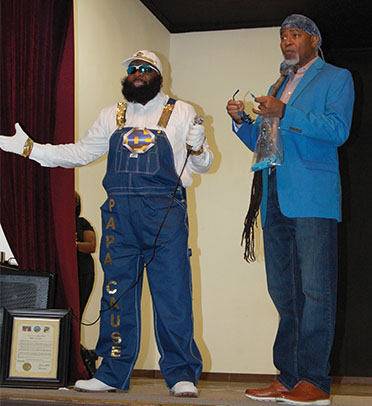By Sarrah Peters
News Editor
When he was four years old, John Solomon Sandridge often watched his father use a No. 2 pencil to make notes on paper. When Sandridge got ahold of the pencil, he wanted to use it as well, but he couldn’t find any paper. Instead he used the first blank page of his family’s Bible, where he drew a stick figure.
“That was my first drawing,” said Sandridge. “It felt good as a kid, and from that point on, I was drawing stick people, and women and their children and dogs and cats. That’s how I started, and I just developed a passion for it. I knew, as I grew older, I knew art was for me and I wanted to be a cartoonist.”
At age 15, Sandridge began pursuing his dream of being a cartoonist by contacting the local newspaper to see how to publish his cartoons. After submitting his work to the newspaper’s headquarters in Montgomery, his cartoon was printed in a statewide magazine. He made $15.
As an adult, Sandridge worked as a painter, painting outdoor signs and eventually starting his own company. In 1990, Sandridge was the first black American licensed by Coca-Cola to create art using the company’s logo and products. He was commissioned to create prints and a sculpture for the 1996 Olympic games in Atlanta. Sandridge also trademarked his own art style, called Numinouneoism.
Sandridge’s love of cartoons led him to create Papa-Cause, a friend of Santa Claus, which Sandridge aims to develop into a feature-length movie.
“One of the most exciting things for me is that Papa-Cause, the idea, the concept of Papa-Cause, comes out of Gadsden, my hometown,” said Sandridge.
Papa-Cause has brought Sandridge back to Gadsden several times. While visiting Gadsden, the director of the Gadsden Museum of Art extended an invitation for Sandridge to display his art in an exhibit at the GMA. On February 1, a reception will be held at the Gadsden Museum of Art at 5 p.m. for the first art exhibit Sandridge has displayed in his hometown in about 20 years.
Sandridge’s exhibit is called “Un-Slaving John Solomon Sandridge.” It carries the same name as Sandridge’s memoir, which is currently underway.
“The art, which is a very small portion of the body of work that I’ve created around this topic, I’m hoping that it will be a visual example of where I am in my life and what I’m experiencing and discovering about myself,” said Sandridge. “I’m in the process of removing enslaving beliefs and practices from my life and who I am as a person that I’ve lived with. This is an exciting journey.”
Editor’s Note: This is the first article in a series that will highlight Black History Month in Etowah County.




